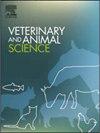Circulating microRNA profiles are associated with acute pain and stress in castrated and tail docked lambs
IF 1.9
Q2 AGRICULTURE, DAIRY & ANIMAL SCIENCE
引用次数: 0
Abstract
Maintaining animal welfare is an essential component of animal production systems. However, multiple measurements are required to inform an animal's welfare state as there are currently no universal measurement tools. Novel biomarkers are increasingly being explored as measures of stress, pain and disease status in livestock. Here we investigate host-encoded microRNAs (miRNAs) as biomarkers of stress and pain to determine the welfare of Australian Merino sheep (Ovis aries) following castration and tail-docking. This study used samples from a retrospective trial that compared the effectiveness of pain-relief given to lambs following castration and tail-docking. Plasma collected from lambs at 0 h and 30 mins that received no pain relief post treatment were investigated. Over 1100 novel miRNAs were identified from deep sequencing of small RNA isolated from serum samples. Altered expression of 18 miRNAs was observed in lambs post-castration and tail-docking, of which one miRNA (oar-miR-1–3p) was previously characterised. A supervised machine learning model identified a five-miRNA signature that classified post-castrated and tail-docked sheep from pre-treatment with 99% accuracy. This study describes the characterisation of circulating miRNAs in Merino sheep and demonstrates that miRNAs may have utility for objective measures of animal welfare status in relation to pain.
循环microRNA谱与去势羔羊和断尾羔羊的急性疼痛和应激有关
维持动物福利是动物生产系统的重要组成部分。然而,由于目前没有通用的测量工具,因此需要多种测量来告知动物的福利状况。人们越来越多地探索新的生物标志物,以衡量牲畜的压力、疼痛和疾病状况。在这里,我们研究了宿主编码的microRNAs (miRNAs)作为应激和疼痛的生物标志物,以确定澳大利亚美利奴羊(Ovis aries)在去势和断尾后的福利。本研究使用了一项回顾性试验的样本,该试验比较了阉割和截尾后给予羔羊的疼痛缓解效果。对治疗后疼痛未得到缓解的羔羊在0 h和30 min采集的血浆进行了研究。从血清样品中分离的小RNA深度测序鉴定出1100多个新的mirna。在去势和断尾后的羔羊中观察到18个miRNA的表达改变,其中一个miRNA (oar-miR-1-3p)先前被表征。一个有监督的机器学习模型确定了一个5 - mirna特征,该特征以99%的准确率将阉割后的羊和尾割羊与预处理羊区分开来。本研究描述了美利奴羊循环mirna的特征,并证明mirna可能用于与疼痛相关的动物福利状态的客观测量。
本文章由计算机程序翻译,如有差异,请以英文原文为准。
求助全文
约1分钟内获得全文
求助全文
来源期刊

Veterinary and Animal Science
Veterinary-Veterinary (all)
CiteScore
3.50
自引率
0.00%
发文量
43
审稿时长
47 days
 求助内容:
求助内容: 应助结果提醒方式:
应助结果提醒方式:


